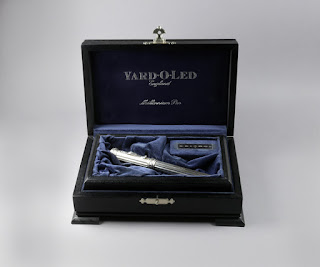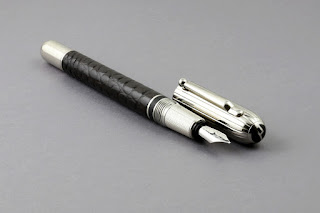 |
| Visconti Homo Sapiens Bronze |
More than five thousand years ago Homo-sapiens marked the dawn of human history and the invention of writing thus began. The same age discovers metallurgy, allowing the mastery of metals which signified the beginning of human evolution all the way to the invention of the wheel.
Visconti conceived the Homo-sapiens range of writing instruments for real writers, for those to whom the fountain pen continues to represent an essential travelling companion, a daily friend to share the same civilization that writing helped create.
The pen is made from a material that is as antique as the world around us: lava from the Etna volcano. Lava has many characteristics that make it very unique in the manufacturing of writing instruments. Visconti has successfully produced a material containing over 50% pure basaltic lava, catalysed together with resin in a formula that is patented and obviously kept secret. The extraordinary characteristics of basaltic lava practically transform it into a material perfectly fit to writing instruments.
Visconti lava characteristics:
Virtually unbreakable: It has a high degree of resilience
Slightly hygroscopic: allowing it to absorb hand sweat during use
Dense: to the touch, allowing the best possible finger-relaxing grip
Unquestionably new in the range of materials employed in the making of fountain pens
Natural Bronze Fittings
All metallic parts of the pen were inspired by the Bronze Age. The Bronze Age, almost contemporary to the invention of writing, marked the dawn of human civilization. The clip, the decorative rings and the metal accessories, with the exception of the piston, are all in bronze. Homo-sapiens is made with natural bronze like the antique formula that does not require plating or protection treatments which alter its original almost pink colour and which can be easily polished with special products.
The high vacuum power filler charging system is made of titanium, the only material resistant to ink aggressiveness.
Top of the pen has Visconti’s 'My Pen' system incorporated. A rare earth magnetic which allows the user to change cap top for his/her personalised initials. This is a lovely touch. The pen has a twist cap but it’s not your normal twist cap. It has a cleverly designed thread that requires less than a quarter of a turn to uncap the pen.
23 ct 950 Palladium 'Dreamtouch' Nib
With Homo-sapiens Visconti introduced the first ever made 23 ct 950 palladium Dreamtouch nib.
Dreamtouch is the term coined to define a nib that requires no pressure whatsoever in order to write, it traces in a gentle way thoughts and words for dream-like handwriting.

Palladium has interesting physical features that allow the production of fountain pen nibs; its manufacturing is possible today thanks to new metal-fusion technologies and to the welding of iridium tips.
Palladium actually melts at much higher temperatures than gold: 1552°C against 1063°C. It is therefore obvious that this metal has better mechanical features; being more resistant than gold and that any manufacturing process involving palladium becomes a lot more challenging.
The international classification system lists only four precious metals and their related titles: platinum, palladium, gold and silver.
The 23 ct 950/1000 palladium nib is the purest precious metal nib ever manufactured in fountain pen history. In other words, it contains 95% pure palladium against 75% pure gold in the 18 ct nib and 58% gold in the 14 ct nib.
Flexibility and Memory: Palladium has the best possible properties for any type of writing, enhanced by some 30% compared to the same nib in 18 ct gold.
Resistance to ink corrosion has been improved up to 100% thanks to the pureness of the material to an extent to which no protection treatment of the plating is needed.
We think of Homo-Sapiens as a fountain pen that can bring to mind a time-frame: starting from lava as generating material, passing through bronze - recalling the beginning of the act of writing, and ending with palladium – the metal of the future.
Technical Characteristics
Homo Sapiens Bronze
Collection: 23 ct 950 Palladium Dreamtouch nib fountain pen
Material: Basaltic Lava from the Etna Volcano
Nib: 23 ct 950 Palladium Dreamtouch medium nib
Metallic parts: 100% bronze
Filling System: High vacuum power filler
This particular Visconti Homo Sapians Bronze was originally purchased in 2014. It has been fully serviced by Hepworth Dixon and offered for sale in original luxury case, outer card box and original documentation. Visit our website:
www.hepworthdixon.com for details. You will also find many other classic fountain pens for sale.





 Barrel and Section: Heavily fluted solid sterling silver barrel, hallmark stamped in the centre with the five A.D. 2000 identification imprints. Towards the front of barrel is the same embossed decorative ring that appears at cap top, again stamped '2000'. 'MADE IN ENGLAND' is stamped on the barrel just above section. The section has a plain surface sterling silver curving profile. A lip ring between section and nib is stamped '925 STERLING'. The section unscrews from barrel to access filling system, this can be via ink cartridge or piston ink converter. Yard-O-Led ink converter included.
Barrel and Section: Heavily fluted solid sterling silver barrel, hallmark stamped in the centre with the five A.D. 2000 identification imprints. Towards the front of barrel is the same embossed decorative ring that appears at cap top, again stamped '2000'. 'MADE IN ENGLAND' is stamped on the barrel just above section. The section has a plain surface sterling silver curving profile. A lip ring between section and nib is stamped '925 STERLING'. The section unscrews from barrel to access filling system, this can be via ink cartridge or piston ink converter. Yard-O-Led ink converter included. Nib:
Nib:













































